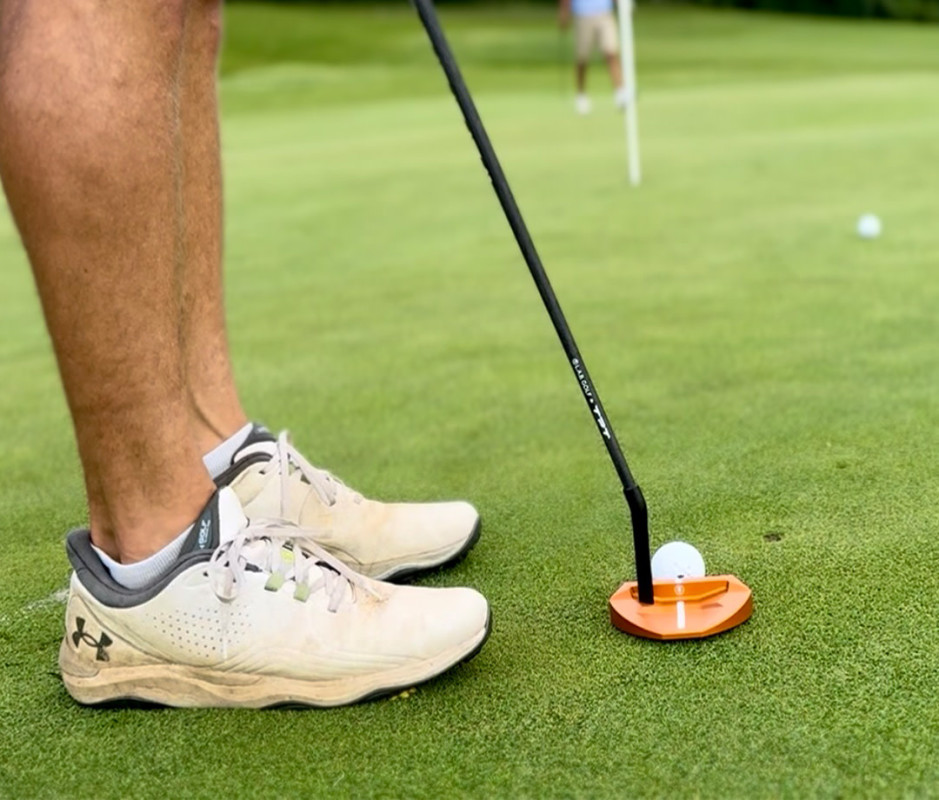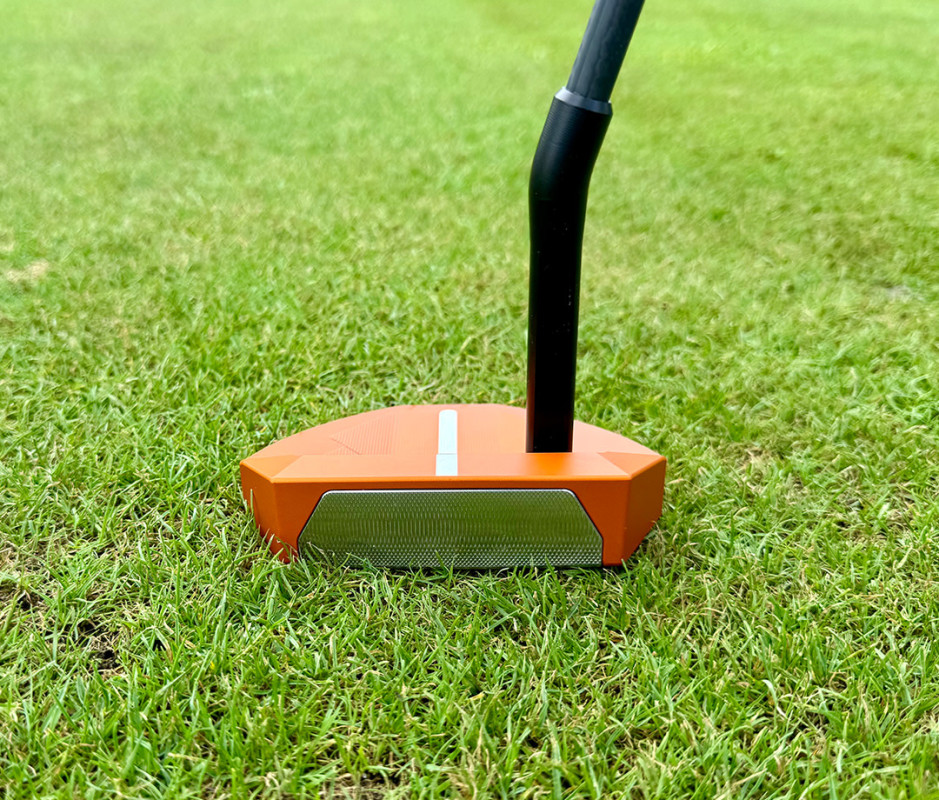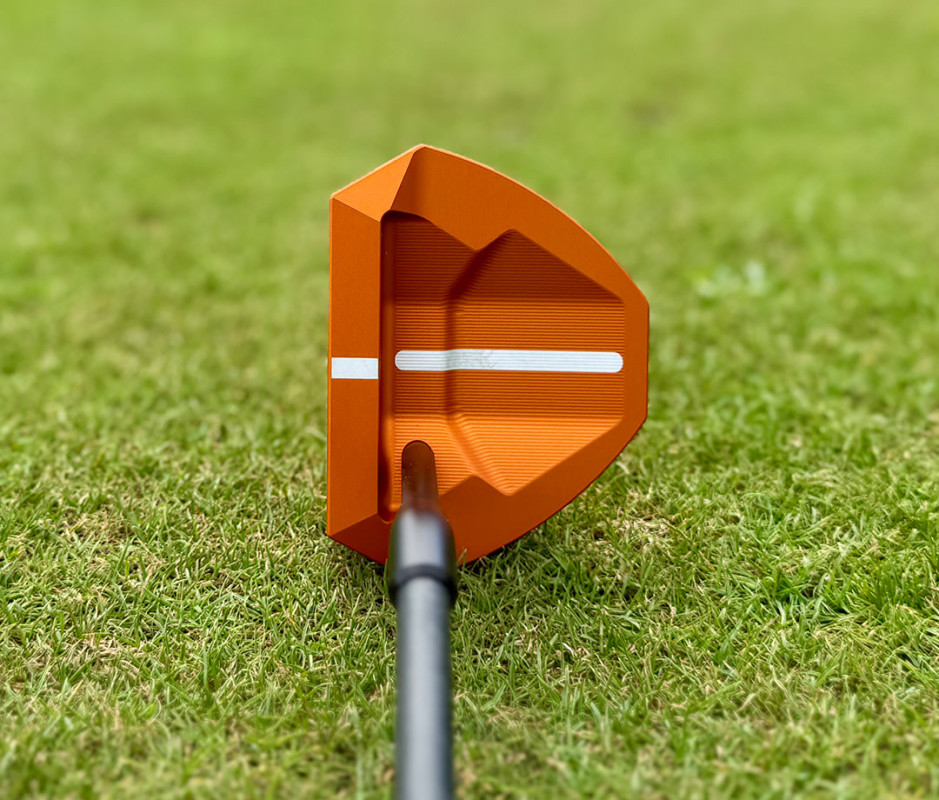Men’s Journal aims to feature only the best products and services. If you buy something via one of our links, we may earn a commission. Prices are accurate and items in stock at time of publishing.
Putting is hard. I know because I’ve three-putted my way across courses all over the country. My only comfort is that I’m not the only one. Rolling a ball into a tiny hole is one of the trickiest parts of a golf game—just watch any PGA pro miss a five footer on any given weekend. And these are professionals. They putt for a living, so what hope do we have?
Oregon-based upstart L.A.B. Golf was created in 2018 with the specific purpose of making the hardest part of the game a little easier. After the break out success of their DF.3 (J.J. Spaun won the 2025 U.S. Open with it) they’ve continued to innovate and design game-changing putters. Enter the brand-new OZ.1i HS, a heel-shafted club that incorporates L.A.B.’s Lie Angle Balance technology, but has the look of a more traditional mallet putter, promising the same square at impact performance with an aesthetic designed to win over traditionalists. I’ve spent the last few weeks testing the OZ. 1i HS, trying to figure out if this new putter will help me sink more putts and avoid the dreaded three-putt scenarios that have plagued my rounds in recent years.
What It Is
According to the minds at L.A.B. (Lie Angle Balance), putting is hard because your putter is working against you. The problem with traditional putters? Torque. The face of a traditional putter can twist during the arc of the stroke, and you have to actively square the face with your hands before impact. There’s a lot of room for human error in that process, and there are dozens of training aids on the market designed specifically to fix this problem.

L.A.B.’s solution is to address the putter itself by creating a club that stays square throughout the arc of the stroke, largely by putting the shaft of the club into the center of the head instead of the heel like a traditional design. They call it “Lie Angle Balance.” Other companies call it “zero torque.” No matter what you name it, the innovation has taken off. Several larger brands have adopted the concept with their own zero torque models, and L.A.B. as a company has grown 18,000 percent since its inception in 2018. L.A.B. has become one of the top five most popular putter brands in the last two years and the indie brand was recently purchased by a private equity firm for more than $200 million.
But not everyone loves L.A.B., mostly because their putters look weird. Take their most iconic model, the DF.3, which most reviewers agree is a cheat code for putting. The club stays so square, it makes it easier to start your ball online, which is one of the toughest aspects of putting. Some of the most influential social media stars love the DF.3 and several pros have started using it. But a lot of people can’t get over how the thing looks. It has a large head and oddly-shaped build. It looks vaguely like a sex toy. Not everyone is into putting with a sex toy.
The OZ.1i HS is a mallet-style putter that at first glance looks similar to other mallet-style putters you’ll find in your favorite golf shop. But L.A.B. is able to maintain the OZ.1i HS Lie Angle Balance with an aluminum riser that connects the shaft to the head at the heel, but shifts the balance to the center of the club. The putter is also highly customizable through either in-person or online fittings. I had the chance to get fitted for a new OZ.1i HS at L.A.B.’s Oregon headquarters—a process that customizes every aspect of the putter, from the thickness of the grip to the weight of the club head.
L.A.B. OZ.1i HS Putter Overall Impressions
I’ve been putting with the OZ.1i HS consistently for the last three weeks. I’ve rolled countless five footers with it on my backyard putting green and spent hours working through putting drills at my municipal course’s practice green. I’ve also had the chance to play the putter during several rounds at four different golf courses with a variety of green styles, from easy resort-style greens to diabolical Donald Ross creations. I’ve putted with this club hundreds of times in the last few weeks, testing it side by side with other L.A.B. putters as well as traditional putters from Odyssey and PXG.
You want me to cut to the chase? L.A.B.’s OZ.1i HS has helped me sink more putts. It’s not a perfect putter and it only addresses one area of a golfer’s putting, but it is an extremely user-friendly club that does in fact keep the face square, making it easier to start your ball on line.

To simplify things, let’s say there are three tangible aspects to putting well. You have to be able to read the green, judge the speed of that green, and square the face so your ball starts on the right line. Squaring the face and starting the ball online is really important, but if you can’t read the green then that line you’ve chosen might be way off track. And if you can’t gauge speed, then you might leave that putt three feet short. I know this because I have a problem with both of those elements of putting. With the OZ.1i HS, you still have to read the green well, and you still have to hit it at the right speed, but that last element, the act of squaring the putter face, is streamlined and simplified. The face stays just as square as other zero torque putters, thanks to the aluminum riser that connects the shaft with the head but still gives it the signature Lie Angle Balance of other L.A.B. clubs thanks to some engineered balancing acts.
This is not L.A.B.’s first crack at a traditional looking putter. The Link 1 is a blade style putter and the OZ.1 is a mallet style putter, both of which look more traditional while still having the signature center-mounted shaft. The OZ.1i HS has the traditional mallet head and a heel mounted shaft, the combination of which is bound to win over traditionalists.
Key Features
Like all L.A.B. putters, the OZ.1i HS has an aluminum head, but unlike many of the company’s offerings, this putter is given a stainless steel face insert as opposed to their standard aluminum face. This is an important distinction, as some early adopters of L.A.B reported trouble with lag putts while using the aluminum-faced putters. The greater the distance the putt, the harder it was to get the ball to the target. Aluminum doesn’t have the same punchy feel as some other metals.

L.A.B. addressed that issue by giving the OZ.1i HS a stainless steel face, which is a much more robust metal choice offering plenty of pop. The shift to stainless steel makes a noticeable difference. I was still expecting the dull feel of other L.A.B.’s, during my first round with the new OZ. 1i HS while standing over some longer putts on the first few holes, but I repeatedly cruised my ball past the hole. Once I learned to trust the stainless steel face, speed wasn’t an issue and I haven’t noticed any problem with getting my ball to the hole on 30 foot putts.
Just about every other aspect of the OZ.Ii HS is highly customizable, from the stiffness of the shaft to the weight of the head. Even the alignment marking can be dialed in to your preference. I played around with different weighted heads, different thickness of grips and different riser-lengths before settling on the version that felt the most comfortable.
Pros
- The face is square at impact
- The putter is hand-balanced and assembled in the U.S.
- Quality materials
- Striking aesthetics
- Highly customizable
Cons
- Expensive
- Small sweet spot
Final Verdict
So how good is this putter? I played 18 holes earlier in the week on a course I’ve never played before and I didn’t have a single three-putt situation. Being able to two putt most holes and drop the occasional one putt saved my score on a day when I had trouble finding the fairway off the tee box. But don’t get too excited. That particular course had a resort-style green complex without any dramatic breaks and very straight forward putts. Yesterday I played a course with notoriously tricky greens designed by Donald Ross. The greens were massive with multiple tiers and wild undulations, and I carded a handful of three putts. Sadly, there isn’t a putter on the market that will fix my green-reading deficiencies. But the OZ.1i HS is very good at doing what it’s designed to do; keep your face square and start the ball rolling on line. Having that aspect of the putting stroke dialed in makes putting a little bit easier.
It’s not all roses, though. Would-be buyers should be aware that the sweet spot on this putter is pretty small. You have to strike the ball in the dead center of the face. If you don’t, the strike will feel hollow and the ball will veer right or left depending on if it’s a heel strike or a toe strike. I don’t think it’s hard to find the center of the face with this club, but other putters I’ve used in the past are definitely more forgiving in that respect.
And you can’t talk about L.A.B. without discussing the price tag of the clubs. L.A.B. putters aren’t cheap. A stock OZ.1i HS costs $499. Custom versions start at $599, and can reach the $1000 mark if you get crazy with it. But I toured the manufacturing facility and I can tell you first hand that these putters are made with precision, and there’s science-based evidence to back the notion that torque can ruin a perfectly planned putt. L.A.B. encourages their customers to go through a custom fitting and offers an online version of the process for free. If you’re going to drop the money on a putter, I highly recommend going through the process.
The more I use the OZ.1i HS, the more I like it. I was never turned off by L.A.B.’s wild designs, but I wasn’t convinced it was worth dropping $500 on any putter, even if it promised to fix an important part of my putting stroke. Consider me a convert to the zero torque movement. I have more confidence standing over the ball now. It is easier to putt with a L.A.B. and I’m convinced the OZ.1i HS will continue to help me sink more putts. After just three weeks with the OZ.1i HS, I can’t imagine putting with anything else.
Why You Should Trust Me
I’m not a professional golfer, but in the last couple of years I’ve grown addicted to the sport, playing multiple times a week and spending more time at the range than any man with a full time job and family should spend. I’ve been testing golf gear for Men’s Journal during that time, writing about a variety of gear, from the best clubs for beginners to the best travel bags for jet-setting golfers. I’ve also been testing and writing about gear professionally for more than 20 years, publishing countless articles in this magazine and others. I love golf, and I believe great golf gear can make me, and you, better at the game.
Related: I Rated and Reviewed the Best Bike Tools. These Deserve a Spot in Your Repair Kit

